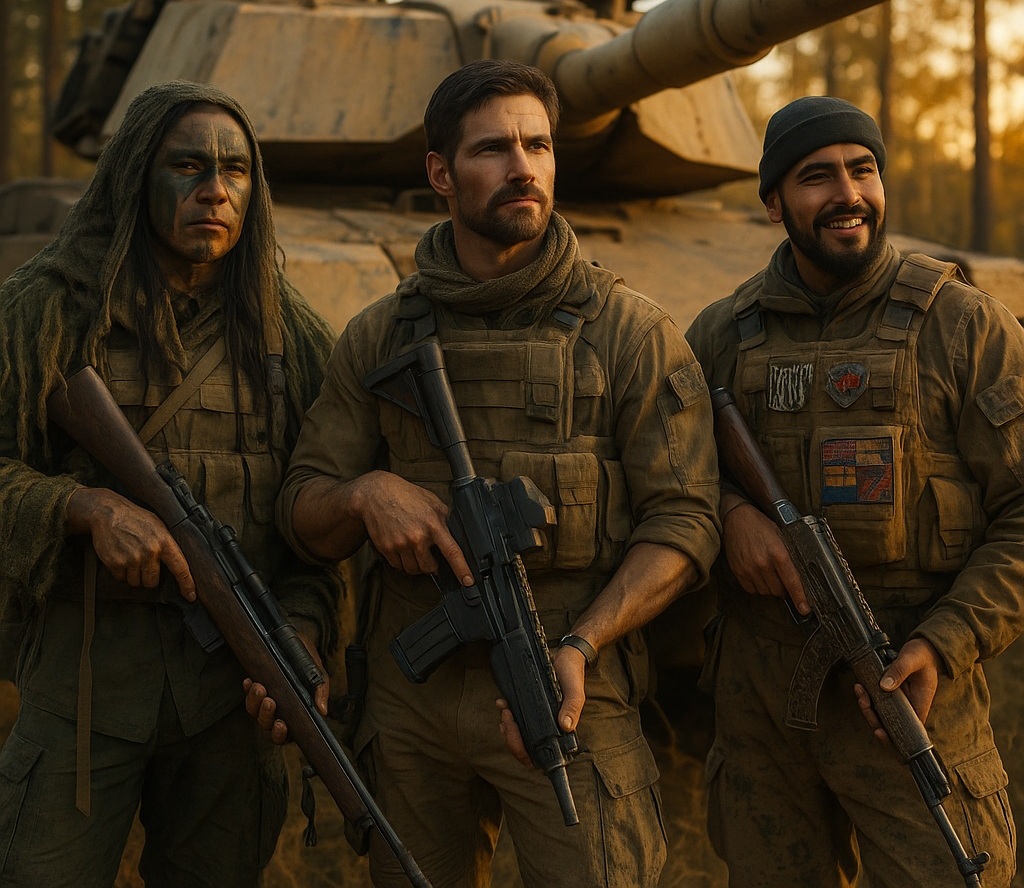//North America - Arkansas//
The tank groaned under its own weight as it crawled through the swampy rise toward the southern plain. Emile Roche stood half-exposed from the hatch, wind biting his face, sweat already mixing with grit behind his eyes. His fingers drummed against the worn rubber grip of his FN P90 as he contemplated the task ahead.
In the distance, the half-built ziggurat of El Yugo Sangriento loomed like a broken promise—sharp lines and half-dreamed glory.
It reminded him of Quebec. Of the final push. The retreat.
They had lost the war in the north. Not in one battle—no, that would’ve been cleaner. It was a bleed. A retreat through frost and hunger, through empty towns and cannibal hordes. The Armistice wasn’t supposed to lose. But they had. And now he was here, crawling through Missouri floodlands with patchwork tanks, borrowed rounds, and shaky alliances.
The Comanche scouts had been the first real edge. They didn’t ride horses anymore—drones and dirt bikes, mostly—but they moved with the same ghost-footed ease. Dispossessed, yes. But not broken.
Their people had been caged, bought, sold. Slaves to the southern traders. So when Emile sent word, they responded. Quiet, but direct.
“They don’t worship gods down here,” one of the scouts had told him, crouched beside a fireless camp. “They build them.”
He hadn’t understood until he saw the concrete ziggurat. It was a scar on the land—arrogant and unfinished. A shrine to empire, dressed in rebar and false stone. The soldiers of El Yugo Sangriento wore red sashes and cartel tattoos, patrolling on bikes with chrome-plated rifles. They paraded their slaves in chains like war trophies.
It lit something in Emile he hadn’t felt since the war.
El Neuvo Legado had come ready to burn. Mateo Zarazúa and his lieutenants moved with pride, their repurposed machinery gleaming in the moonlight. Old utility trucks reinforced with tank armor. Flamethrower crews made from converted grain sprayers. Their infantry sang the songs of their ancestors—quiet, stoic—as they lined up behind the armored columns.
Emile had proposed the feint. Let the Legado draw fire—use their reputation, their theatrics. Let the Yugo believe it was just a rival cartel coming for territory.
Then the Armistice would arrive. Silent. Calculated. Ruthless.
The assault began at dawn.
The first shell struck the guard tower just as the sun cracked the mist. Fire bloomed and the swamp lit gold. Emile’s tank—call-signed Tannhauser—led the center push. His gunner opened up with a belt-fed .50, sweeping the courtyard. Cartel scrambled, red sashes fluttering like broken flags.
He raised the FN and fired short bursts at the shapes fleeing between the tents. A slave pen burst open in the chaos—barefoot civilians flooding out in the midst of the fight.
The plan held however.
The Legado smashed into the west wall with noise and chaos, mortars pounding concrete, flamers spraying high. Emile’s forces flanked from the north, moving through the drainage culverts mapped by Comanche scouts weeks earlier.
Then, as they neared the base of the ziggurat, the enemy changed.
Slaver elites poured out in ritual armor—modern riot gear stylized with Aztec gold and cartel insignia. They carried machetes, pump-action shotguns, and molotov cocktails.
The fight turned brutal. Trenches. Close range. Emile dropped from his hatch, club in hand, slamming a masked enforcer into the side of his own war machine and ending his life in a gory spectacle.
There was no elegance. No glory. Just necessity.
Hours later, smoke rose from the top of the pyramid. The flag of the Yugo burned where their false god once stood.
Emile sat on the tread of his tank, armor scratched, helmet dented, blood dried into the handle of his club. Mateo approached with a half-smile, both men too tired to speak.
They didn’t win a war that day.
But they started something.
And for Emile Roche, that was enough.



Comments